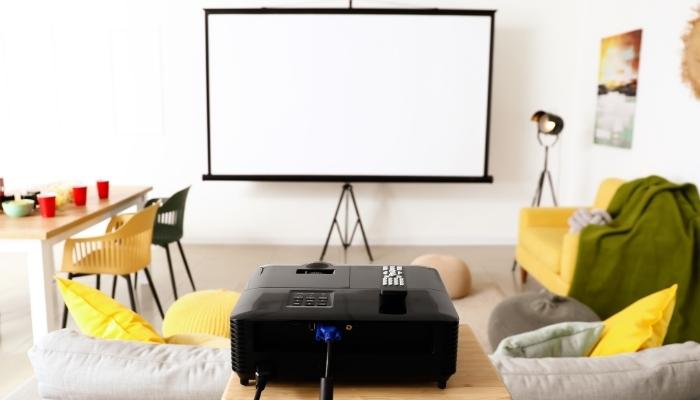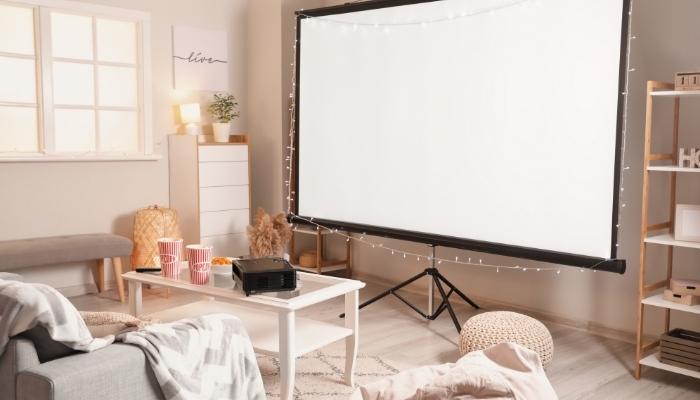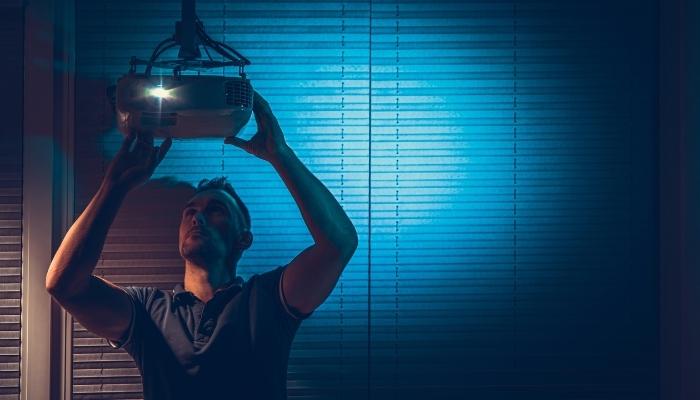When it comes to home entertainment, there are several options available that can help create an incredible home theater. But one option you can't overlook is a home theater projector!
Projectors emphasize image quality and contrast to provide deep blacks and rich color saturation that immerse you in the viewing experience. And since they work in dark rooms, they create the feel of an actual movie theater in your home!
So, if you're ready to learn more about projectors--you're in the right place! We'll go over the basics you need to know so you can shop with confidence!
Type of Projector

The first thing you'll want to consider is what type of projector you need. Each projector type has its unique set of benefits, so it's all a matter of preference when deciding on one.
- LCD Projectors: use a liquid crystal display to project images with high color accuracy and a wide range of colors. However, they can suffer from "ghosting" or "crosstalk" when one image bleeds into another and you see the frame being pulled down. This usually happens because of the way the projector is set up, so check If the VGA cables are bunched or close to power cables and that the lamp isn’t losing luminosity.
- 3LCD Projectors: have three LCD panels displaying different colors, creating a vibrant image with excellent color output and brightness.
- DLP Projectors: use a digital light processing chip and a mirror to reflect light and create incredibly sharp images with fast refresh rates. However, they can sometimes suffer from the "rainbow effect," which is when you see flashes of colors in your peripheral vision.
- LED Projectors: utilize an array of light emitting diodes to create images and use less power. These projectors have an incredibly long lifespan but sometimes have lower contrast ratios than other types of projectors.
- LcoS Projectors: have liquid crystal chips with mirrored backing that create super high-resolution pictures, with excellent contrast and black levels.
Brightness

Next, you'll want to consider the projector's brightness, which will determine how far away the projector can be to project a clear image. Brightness is measured in lumens, so the higher the number of lumens, the brighter the projector will be.
Generally, you'll want a projector with at least 1000 lumens for a home theater setup. But if you plan on using your projector in a brightly lit room, you may need a projector with 2500 lumens or more. You'll also have to consider the two brightness measurements: white and color.
White is the white light output and indicates the total amount of white light emitted by the projector. The color light output determines how bright the colors will be, so the higher the number, the more detail, and vibrancy you can expect. Make sure to compare both of these. If the color brightness is lower than the white, the images will be dark or dull.
Note: A 2000-lumen projector creates a bright, watchable image on a 100-inch screen in a dark theater room.
Contrast Ratio
Another important aspect of home projectors to consider is the contrast ratio, which shows the difference between the lightest and darkest parts of an image. A higher contrast ratio means more detail will be visible in both the light and dark areas of an image. So, if you want to view content with great depth and dimension, pay close attention to the contrast ratio.
Typically, you'll want a projector with a contrast ratio of 1000:01 or higher, like a ratio of 3000:1 for darker black levels. However, if you plan on using your projector in a brightly lit room, you may be able to get by with a lower contrast ratio.
Pro Tip: Look for projectors with HDR technology for an even better array of color, brights, and detailed shadows.
Throw Ratio

What, another ratio? Yup. Home theater projectors have a throw ratio, which determines how wide the image will be when placed at a certain distance from the screen. This is calculated by dividing the distance between the projector and the screen by the width of the projected image. Basically, it helps determine the ideal room size it will work in.
A shorter throw ratio is ideal for smaller spaces because you place the projector closer to the screen and still have a large, clear image. A longer throw ratio means you'll need to place the projector further away from the screen, which is excellent if you want to mount it.
Keystone Correction

Another essential feature in a home theater projector is the keystone correction. This allows you to adjust the projected image's shape, which is especially useful if your projector is not perfectly aligned with the screen. Misalignment can happen for any reason, like adjusting the room size or making the screen bigger.
Most projectors have at least some keystone correction available, but automatic keystone correction is best, especially if working with a small space. Digital keystone correction makes it easier to adjust the image, so it's always aligned with the screen. However, there are ones with manual keystone correction where you have to adjust the lens physically.
If you’re planning to mount your projector, automatic keystone correction is the most ideal, since it’ll be harder to reach to adjust if manual. But if you can easily reach your projector and want to save on your budget, a projector with manual keystone correction is ideal.
Other Considerations
Once you have the basics down, there are other things to consider before you make any decisions. Some of these include:
- Automatic Iris: closes down during dark scenes to make images darker and opens back up for bright scenes to maximize brightness.
- Dynamic Lamp: offers dynamic dimming of the image brightness, so you can see what happens in dark scenes. This feature also extends the lamp life.
- 3D: most projectors have 3D technology, but they probably won't come with the glasses to view it.
- Lens Shift: allows you to adjust the image's height separate from the projector's height, which gives you more placement options.
Time to Shop

These are just a few things to remember as you shop for a home projector, but each is important to consider when creating your dream home theater room. So, if you're ready to start looking, Toton’s TV is the place to go! We have a wide selection with plenty of options to choose from.
Still not sure what to look for? Give us a call! Our team is happy to help you find what your need to bring the theaters into your home!